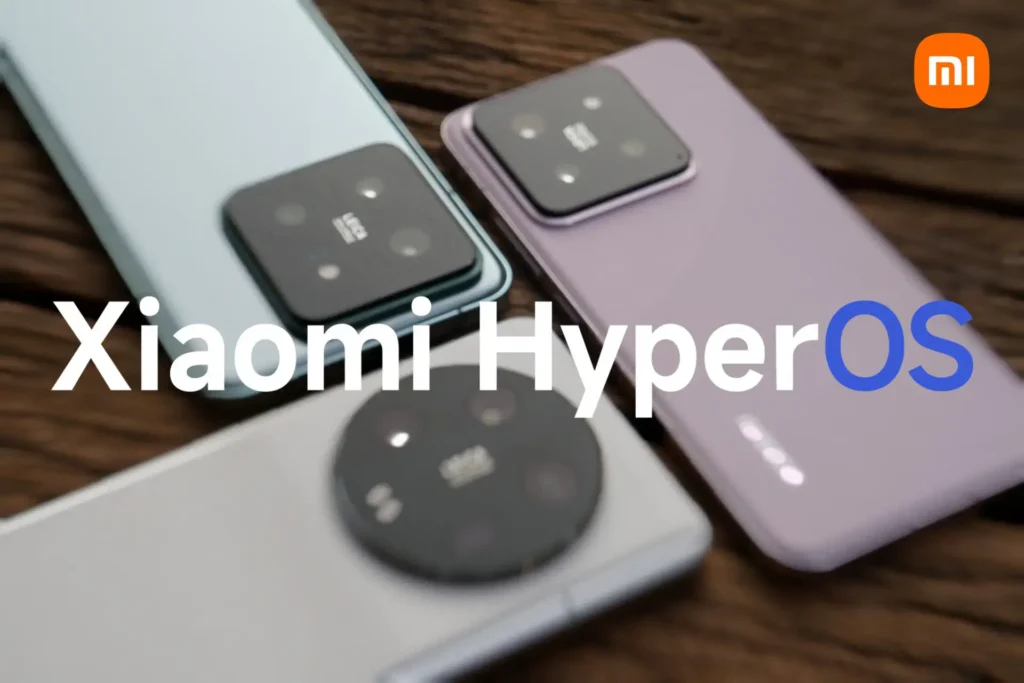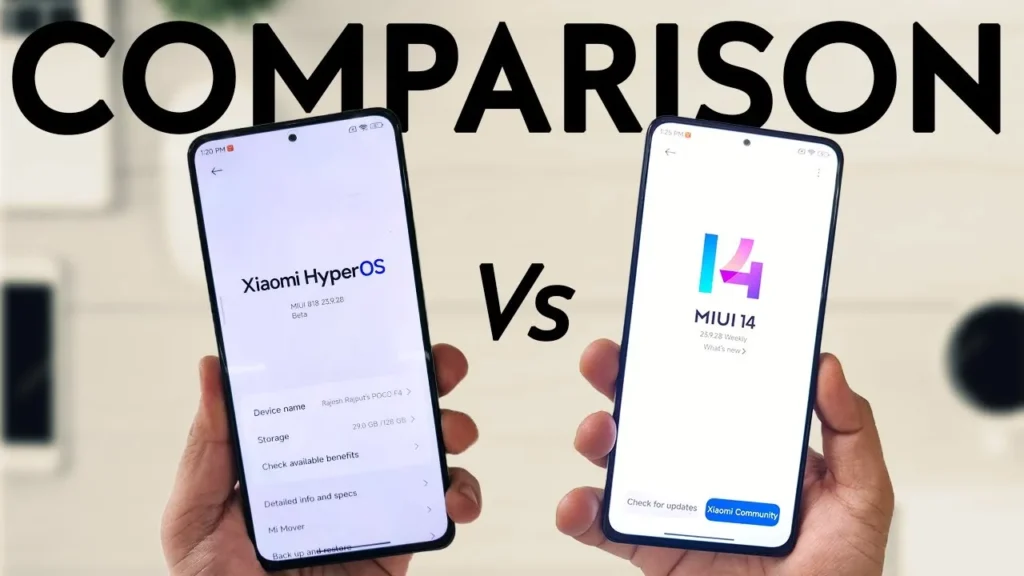hyperOS, If you are curious about hyperOS, the new operating system from Xiaomi that will replace MIUI, you may want to read this blog post. In this post, we will give you some information about HyperOS, such as its features, device support, new things, and comparison with MIUI 14. HyperOS is a human-centric operating system that aims to connect personal devices, cars, and smart home devices to Xiaomi’s smart ecosystem. It features a fresh user interface, low-level refactoring, intelligent connectivity, proactive intelligence, and end-to-end security. HyperOS is pre-installed on the Xiaomi 14 series of smartphones, the Xiaomi Watch S3 smartwatch, the Xiaomi TV S Pro MiniLED series, and other devices.
It will also be rolled out to older Xiaomi devices that are eligible for the Android 14 update. HyperOS introduces some new things that are not present in MIUI 14, such as advanced textures, bloatware uninstallation, font systems, and new lock screen customizations. HyperOS also has some improvements and innovations over MIUI 14, such as performance optimization, AI enhancements, smart connectivity, security, and UI changes.
Features of hyperos

HyperOS is a human-centric operating system that aims to connect personal devices, cars, and smart home devices to Xiaomi’s smart ecosystem. It features a fresh user interface, low-level refactoring, intelligent connectivity, proactive intelligence, and end-to-end security. Some of the features of HyperOS are:
Performance optimization
HyperOS efficiently maximizes the hardware capabilities of various devices, improves app startup and background memory, reduces disk latency and power consumption, and supports flexible distributed collaborative computing.
AI enhancements
HyperOS provides AI-generated text through the XiaoAi Input Assistant, AI image background removal, and natural language image search. It also allows users to capture text on photos, convert doodles into paintings, and search images using natural languages.
Smart connectivity
HyperOS connects more than 200 products from Xiaomi, from smartphones and smartwatches to TVs and cars. It uses HyperConnect, a device center that allows users to control and share data across devices. It also has Hypermind, a smart UI that adapts to different screens and scenarios.
Security
HyperOS has a secure privacy framework that protects user data with comprehensive hardware-level protection. It uses a self-developed TEE (Trusted Execution Environment) microkernel, which is independent and verified by formal methods. It also strengthens the system app security and encryption.
June 2024 Security Patch: The benefit of these enhancements is that it immunizes the system from various threats which can make efficiency updates. The Redmi Note 12 Pro 5G was the first to lay its hands on it in June 2024, With the likelihood that others will soon follow.
UI changes
hyperOS has a new render pipeline that supports complex rendering, high-quality materials, and dynamic glass. It also has a flexible frame that adapts to different windows and layouts. It offers better multitasking and productivity with a new window controller, split-screen windows, and workstation mode. It also has artistic lock screen customizations, such as turning photos into posters or magazine covers.
Device support

HyperOS is pre-installed on the Xiaomi 14 series of smartphones, the Xiaomi Watch S3 smartwatch, the Xiaomi TV S Pro MiniLED series, and other devices. It will also be rolled out to older Xiaomi devices that are eligible for the Android 14 update. Some of the devices that will receive HyperOS are:
- Xiaomi 11 / 11 Pro / 11 Ultra / 11T / 11T Pro / 11i / 11 Lite
- Xiaomi 12 / 12 Pro / 12T / 12T Pro / 12S / 12S Pro / 12S Ultra / 12 Lite
- Xiaomi 13 / 13 Pro / 13 Ultra / 13 Lite / 13T / 13T Pro
- Xiaomi Mix Fold / Fold 2 / Fold 3
- Xiaomi Civi 1S / 2 / 3
- Xiaomi Pad 5 / Pad 5 Pro / Pad 6 / Pad 6 Pro
- Redmi Note 11 / 11R / 11T / 11T Pro / 11T Pro+ and all 11 series devices
- Redmi Note 12 / 12 Pro / 12 Pro+ / 12 Pro Speed / 12 S / 12 Turbo
- Redmi Note 13 / 13 Pro / 13 Pro+ / 13R Pro
- Redmi K40 / K40 Pro / K40 Pro+ / K40S / K40 Gaming
- Redmi K50 / K50 Pro / K50 Gaming / K50i / K50 Ultra
- Redmi K60 / K60E / K60 Pro / K60 Ultra
- POCO C51 / C55
- POCO X4 / X4 GT / X4 Pro / X5 / X5 Pro / X6 / X6 Pro
- POCO F4 / F4 GT / F5 / F5 Pro* POCO M4 / M4 Pro / M5 / M5s / M6
- Redmi 12/12c/12R 5G
New things
- Dynamic Island-like Animations: Charging, silent mode, and hotspot sharing trigger interactive animations mimicking Apple’s Dynamic Island feature.
- Advanced Lock Screen Customization: You can personalize fonts, styles, text, and background effects, creating unique lock screens.
- Seamless Transition between Lock Screen and AOD: The always-on display reflects your chosen lock screen for a cohesive look.
- New Window Controller: Effortlessly switch between window shapes and manage split-screen apps independently.
- Workstation Mode: Unlocks a desktop-like experience with improved multitasking and productivity features.
HyperOS introduces some new things that are not present in MIUI 14, such as:
Advanced textures
HyperOS adds rendering effects like blurring across the system, which enhances the visual experience and realism.
Bloatware uninstallation
HyperOS allows users to uninstall most of the pre-installed apps that they don’t need or use, such as Mi Video, Security, Gallery, and Games. This gives users more control over their storage and performance.
Font systems: HyperOS supports more than 600 languages, 100,000 glyphs, and 20 writing systems, making it more accessible and diverse for users worldwide.
End-to-end security
HyperOS has a secure privacy framework that protects user data with comprehensive hardware-level protection. It uses a self-developed TEE (Trusted Execution Environment) microkernel, which is independent and verified by formal methods. It also strengthens the system app security and encryption.
Comparison

HyperOS and MIUI 14 have some similarities and differences, such as:
Similarities
Both operating systems are based on Android and offer a familiar and user-friendly interface. They also have similar layouts and designs, such as the control center, the app drawer, the notification shade, and the settings menu. They also share some features, such as the dark mode, the always-on display, the floating windows, the game mode, and the super wallpapers.
Differences
HyperOS has some improvements and innovations over MIUI 14, such as performance optimization, AI enhancements, smart connectivity, security, UI changes, advanced textures, bloatware uninstallation, font systems, and new lock screen customizations.HyperOS also has a smaller firmware size (8.75 GB) compared to MIUI 14 (13.08 GB), which may affect the storage and speed of the devices.
Conclusion
hyperOS is a new operating system from Xiaomi that aims to provide a human-centric and intelligent experience for users. It offers a fresh user interface, low-level refactoring, smart connectivity, proactive intelligence, and end-to-end security. It supports various devices, from smartphones and smartwatches to TVs and cars. It introduces some new features that are not present in MIUI 14, such as advanced textures, bloatware uninstallation, font systems, and new lock screen customizations. It also has some improvements and innovations over MIUI 14, such as performance optimization, AI enhancements, smart connectivity, security, and UI changes. HyperOS is a promising operating system that can enhance Xiaomi devices’ user experience and satisfaction. Thank you for reading this blog post; we hope you found it helpful and informative.




